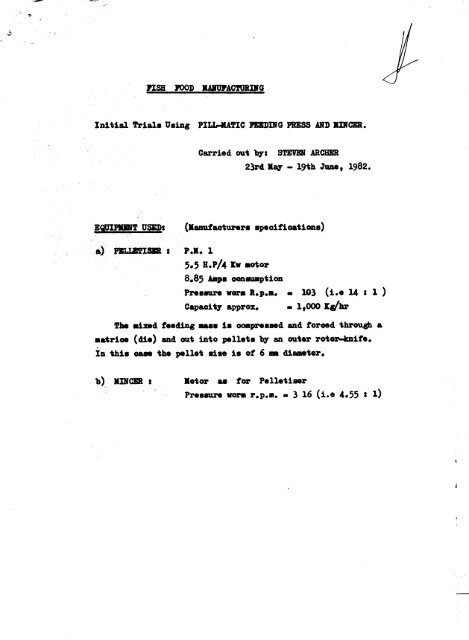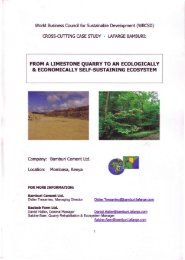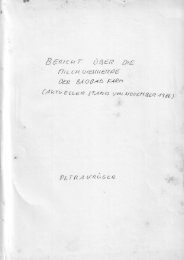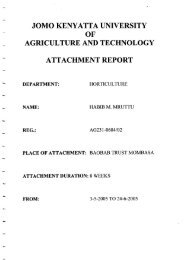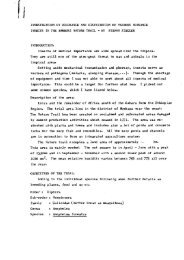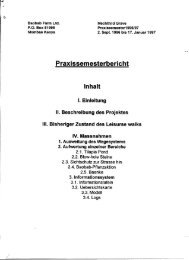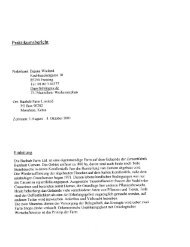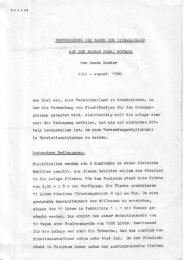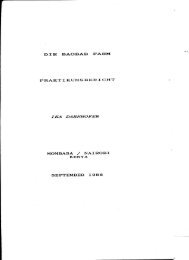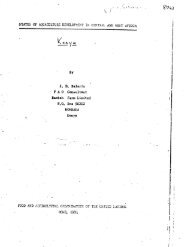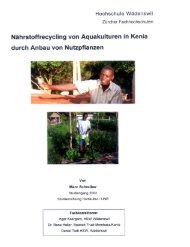You also want an ePaper? Increase the reach of your titles
YUMPU automatically turns print PDFs into web optimized ePapers that Google loves.
Carried ou" by I<br />
STEVEtl ARCHER<br />
23rcl M. - 19"h June, 1982.<br />
<strong>EQUI~</strong> <strong>Up</strong>;<strong>pa</strong> (aarmtacnurer•• pecit1oa"iOllB)<br />
~) PJlLt&'naR. P.K. 1<br />
5.5 B.P/. X•• cnor<br />
8.85 Jap. OOIl8WIption<br />
Pressure •••• R.p... • 103 (i.e 14 I 1 )<br />
Ca<strong>pa</strong>ci"7 approx.<br />
• 1,000 XJhr<br />
Theai_cl teecling au. ls OOlIpNs88cland toroed through a<br />
.a"rloe (die) and out into pelle"s 'b7 an ou"er rcnor-bite.<br />
In this oase the pellet si •• i8 ot 6 •• di_ter.<br />
b) KUCBR I a.tor as tor Pell.ti88r<br />
Pressare vora r.p.a •• 3 16 (i.e 4.55 I 1)
(:1) !J!!! PISII P!LL!l1<br />
lOkg 20 kg )0 kg 40 kg<br />
JaSB 1PISII 33<br />
COT'f(lI lID CAD 33<br />
VIDIA!' POWID 10<br />
MAID'_ DAL 14<br />
VA.!D'. ADJD<br />
3.3 6.6 9.9 l3~<br />
3.3 6.6 9.9 13.2<br />
2.0 4.' 6.0 8.0<br />
1.4 2.8 4.2 ,.6<br />
1 1.'<br />
2 3<br />
(MOIS!UIBCOlt.' • 37.~)<br />
10 kg 20q )0 kg<br />
rJldI BBAD9 20<br />
1PIDS P!l
(ii) Seooacll3teed the 11&1.. p1'Il .a1 throup - this being talr13<br />
abllOrbentaac1. <strong>Up</strong>t t tuu to lIOakthe moisture up reaaining fr_<br />
--<br />
the fish, with.t bloakiag the cUe. Do aen teed cotton ••ed oake<br />
atter ft. or 8D3other hip lIoisture content OOIlpoD.ent.As cotton<br />
••• d cake -"e.I .0Ud when7CMclo. 8•• ti.a the llaobiDekee<strong>pa</strong><br />
taming bat the ootton h•• llou.l48dit •• lt around the wora.<br />
(iii)<br />
,ha. teed the cotton ••• d, slewer than the others clueto 1arse<br />
hard aInmk.. :BcUlthe oottOJl••ed and the aai.. geraaMal need griading<br />
at 1e•• t trioe.<br />
ti••••<br />
'lhe7 Callbe ted tosether the MCOIld(and third)<br />
(iT) Peeclingthe compOllents in at the back ot the mouth, (the ead<br />
•• arest the motor) _au<br />
that 7ou.Calloover the reat ot the llouth with<br />
the bucket, preTenting too _oh tood aettiag epm baelt oa.t.<br />
Abox coa1ddo with beillg producedthat fits<br />
('hi •. ooald ad.clto the Atet., ot a claD&eroua _cbiDe).<br />
aroaDdthe mouth.<br />
(T) BoB't feed fre. fish after grain without first oleaning out the<br />
bOlll.<br />
PIlLLB'nSDlG<br />
BD'OBE S'lAR'l'DG<br />
(i) Greate/vase1iae the iJmer and outer rillS on both sides of the die -<br />
stop. knives squeaking.<br />
(ii) are.,./Vueline the outer and inner edges of the die - hopefu113<br />
a110llsfor eaaier retDOTal.<br />
(iii)<br />
'lighten the Alaa 07 nat bet•• eni aDd! of a turn 1I0000e than<br />
haDdtight.<br />
(ii.T) II8M t1gb.tlln the la't8a _tU' r.U.,<br />
!l9J!GBA'1'.I<br />
(i) ,he better IIlixedthe food, the taster<br />
e.,.<br />
d1strilnltian of lIoisture in it<br />
(ii) Ideal if a pellet is producednear13 1 _ lODge<br />
if can be fed, clueto a lION<br />
If fed too fast the machineblocka, it fed too alowbuds of halfai<br />
••d pellets are produoed.<br />
(iil)<br />
Allowa break after ""17 10 - 15 kg tor the aach1neto olear<br />
~ iapenclingbloakages (dOll't stop the lIotor).<br />
(iT) ,he {eea rate needs to be practioecl.<br />
•../3
(1)<br />
(11)<br />
(11i)<br />
(1v )<br />
heting<br />
Ra"e "00 tan<br />
K01s-ture oon"en" ot mirnre "00 low<br />
Jl1Dure no" mixed pYper17 - SOM <strong>pa</strong>rts "00 ch7<br />
I.A<br />
!<strong>Up</strong>s of 00""0.11seed cake tha" ge" in"o "he grOWlc1II1xture t<br />
when thrown eN" ot the grinder.<br />
Blockages ar •. ot"en preoeeded 'b1'a change in motor tOlle.<br />
It illa 1s J:aeard in "1ae, wa"er should be poured in". "he lIachiDe.<br />
S_·U.a the extra m01sture allows 1t to olear 1".lt.<br />
(1) UIUIOl'eW~ ou"er riAB<br />
(11) 1UldoA18ll-kel ." aad reaOft wuhers &ad oa.ter ladte.<br />
(111) '1'ara "he W01'Il uiAB a 19 _ open eaded. spumer - t1ts 0.11"0"he<br />
end of ~e shaft. C1oabr1. to begin with ('bao1ara:N.a) as this puIles<br />
"he die oa.1I. !.ben remove the inDer kn1fe and turn "he worman"i-ol""<br />
wiee "0 push the food ou". 0.1108"he food 1s 100" the AlaD ke1' nu" aIld<br />
block 08Il 'be put baok •. and. ued "0 pull the •••• eN". eaU. "he ~1<br />
before return1ng werta~ otherwi. food gets puhed 111"0~e bearinge aad<br />
behind the bac* of "he W01"ll.<br />
(1v) The mo'tor has Ba •• "_"10 •.••••• " when onr1oaded. Doa.,,, U7<br />
sad restart the machiDe •• it ORts oat, as it 1s blocked &ad1'- will<br />
"'17 blow the :ftl.s.
lB'l'lmIlDtDG TBJ: MOS! PRACTICALPac.TAaB 0' 1IBISH PISH THAt<br />
CB BB ADlBD TO CltOUO SPJICIjI, ULAPIA Pm.JBlS '1'0 IUD .l PJrLLBT<br />
or :rooD~ALIft'.<br />
P.lle".<br />
•••• proclu.oecl aiA, tJarM ditt.rea" he. ti. peroen"aaesl<br />
(P.roan•••• et aoinve cl he. ti •• ~ iA srowulpell.t •• ~)<br />
* (1) CCM'iU'!<br />
Ua1.JLB ~ Jlrellh Pi. and.5Of, Or_cl Speoial P.ll." •<br />
•• ill'trareOGIltut 4~<br />
If_ maoMneru<br />
bloald.na- "he pellet.<br />
well, e••113 haDclliA,the 10 kc wi"hout<br />
prod.uoecl •••• ta1rq larP.<br />
'btataot ve-q<br />
o.<strong>pa</strong>ct - teadiq to 'breat.4p a U"tle wheaapreaclout tor dJ7iAg.<br />
Dryin, vu ditti_lt<br />
ruoid. bavia, 'beenspread ftt<br />
* (11) SW!<br />
d:u to oODtiAU0U8 raiA, aad."" pellet. weat<br />
iA the .ecl tor 24 hours.<br />
UIIiac 3» he_ ftab aad.6fI/o Ground.Speoial<br />
3_<br />
Pellet •<br />
• oi••.• OGIltut<br />
lfhe ••• hine ••••••••• 10 kc, at a .1__ rate thall (1) bat<br />
with_t 'bloold... Iftae ,.ilet. were -.aller 8ILc1. t1aer. !h. peU.t<br />
dried. ca1eJter o1m.nal7 Md.at.,ecl <strong>pa</strong>la"ible tor at lean 48 hour••<br />
*CU1) SDI!.<br />
Uaia, ~ hellh 'i. _cl 7'" Oroucl Speoial P.llet •<br />
• oill'trareOODtut27.~<br />
pellet.<br />
BISUJJ!S<br />
If_ .ubt M b1.oob4 betore 10kg _lcl be tecl to it, the<br />
produeed.were oa.<strong>pa</strong>ot, eaa111'dri.d., 'bein, alaost too harcl.
CClfCLtJSICIlS<br />
Witha aore afteotift dr.r1Dcay.t. tbaDI ued. the 4~ lI1%ture00\1ld.<br />
be aore practioal. Aa. icleator a better ayatemooald iavolft t.be .ld.<br />
•oof't.. - drier". It a -.11 _ab. wire aettlllg vu laid along t.be<br />
.helfts the pellet. oou.l4be apre•••.• t OIl the shel..... 'hi. would.<br />
ha.•• _other benetit a<strong>pa</strong>rt trOll allowing a larae oiroulatiOD.ot air<br />
_oaget tlle pellet.,<br />
be ••.••d at.<br />
as it raiD approached.the wh.le struoture Oftld.<br />
the ab.e4,pellets &Ad. all. Thethou.t .t uaiag the<br />
.Gbr tor dr71agthe pellets d.uringthe raiDs hall three di.ad.vaataaes<br />
that I ••ea P1J'atq the saoker d••• aot ha.•• a "I8r7 ~ •• oa<strong>pa</strong>ciV;<br />
I eatiaat. 30 kg .t pellets being dried in it at a ts.-; at the lIOat;<br />
20 kg being a... ,"bule oa<strong>pa</strong>oit7• SeOOA41¥ the ooll•• ti_<br />
.t,l'ael<br />
tor tU .oker is easier II&1dthan d.••e. file rea __ *ing tilapia<br />
••••••••••.••• due to a laalt ot the reqaired ooooauthullk••<br />
Third.17'a. tilapia lik. to .at _ok.d pellets, how••n81ti.•.•are thq<br />
to ditt.ren.s<br />
in tut.?<br />
The si.. of the pellet. producedwas larger beOlllUl8 the teed is able<br />
to <strong>pa</strong>ss through the die futer thaDa drier m1xhre; the stre_ is_<br />
1ng oat of the die ,.ts longer bet.en kaite cuts than it wouldit the<br />
8ixture wasbeing aOYedat a slower rate.<br />
be overo••<br />
This large pellet size oould<br />
b7 te.diag the •• chine slower. This wouldalso result 1n<br />
the aixture spendinga loaav ti_<br />
inere••• the t1rmnessof the pellet.<br />
in the die;;:a factor that could<br />
Howeverbecause of the higher<br />
lI!0istur8oOl1tent,whichacts as a lubricant in the die, a wetter pellet<br />
is al1faJ'sgoag to be le.s ooa<strong>pa</strong>ctthan its drier equivalent, whenboth<br />
are dried outI accepting that the drier eq1iivalent, 1las.eilO1lgh .•• i_t ••.<br />
ia it to allow gellatllli.ing<br />
The27.~ .oisture<br />
to take place.<br />
content mixture provedtoo dr7 tor the machine,in<br />
this experiment. Thi. doe. not tally with the results ot the 1st<br />
experiment. A mistake of using too ~l batch•• - (only 5 kg) - in<br />
the 1st experimentmeantthat the machinewasable to puf!lhOld 5 kg<br />
ot drier pellet. before it beganto block up~ In this experi.llellt10 kg<br />
batches wereused meaningthat the drier IDirare had tt.<br />
maohirle.<br />
to blodt the
Having to handle a batch of 10 kg as opposed to 5 kg means that the<br />
heat in the die builds - up to a higher temperature, which has<br />
the effect of reducing the moisture content of the mixture further.<br />
The 35'/> moisture content mixture worked best in this experiment.<br />
Although the machine was not able to run as fast as it did vi th the<br />
45% minure, IDa3'be with a larger batch than 10 kg it would alsc lead<br />
to a blockage in the machine. The pellets were 1-010 easier to dry,<br />
and did not go rancid within the 48 hours that<br />
they were kept.<br />
Rancidity will alW83'Sbe a big problem whentrying to store these<br />
pellets containing tresh fish. This is because rancidity is due to<br />
oxidation of highly unsaturated fats (lipids) of which tresh fish has<br />
more than its fidr share; this oxidation occurs in two stages; the<br />
second causing an "otf-flavour"<br />
and sometimes the production of toxic<br />
compounds. It tile•• pellets needed to be stored for any length ot tillle -<br />
over the weekendtor instance the addition ot an anti-oxidant<br />
(etho2'3"gu.inaM botylated ~dro~toluen. are suggested by Fish Feed<br />
Technology")<br />
could help prevent rancidity.<br />
SUMtURY<br />
A happy _dium between the 45% mixWre and the 35% IIlixture IRq be<br />
'he answer, i.e. around 4C1fo aoi8ture content. This would prove<br />
easier to dry than the 45% III1xtureand easier tor the machine to<br />
work on than the 1~.
IDBAS ON PELLETING<br />
(i)<br />
Heating of the food<br />
If the food oouldbe heated. in a large drumfor instance, I' a<br />
sure this wouldresult in a higher<br />
This wouldhave twobeneficial affeots at least:<br />
quality pellet being produced.<br />
Thehigher teaperature<br />
wouldresult in increased gellatinising between<strong>pa</strong>rtioals - one of the<br />
major faotors affecting pellet firmness.<br />
Seoondl.yheating of the mixture<br />
- <strong>pa</strong>rticular13 if the drumwasrevolved - wouldresult in a moreeven<br />
distribution<br />
of moisture. This wouldcause an increase in the lubricating<br />
affect of moisture as food <strong>pa</strong>sses through the die.<br />
(ii) Moisture oontent of tood<br />
Thedrie'" the mixture - the tirater and easier to dry the pellet is -<br />
aocepting that the mixture has enoughmoisture in it to gelatise.<br />
Also the quicker the machineblocks and the slowet' the pr~ss<br />
of producing<br />
pellets becomes.<br />
Thewetter the mixture the less firm the pellet and the moredifficult<br />
it is to dry.<br />
Howeverthe maohineruns easier - less blocking.<br />
I workedVi th a moisture content of about 31fo. taking tresh fish<br />
to have a moisture content of ~<br />
and prawnheads «J1, (estimated)•<br />
•. ./2
Somefeeds, suchcas gl"OW1d maizemeal, are especial~<br />
useful in<br />
pellet produoingdie to their "Binding"quality. Therefore before<br />
a componentis introduced to the mixture take into account its binding<br />
qualities, this also appliea to rearwing a OOIlpollent froma mixture.<br />
(i)<br />
I access the "binding" qualities<br />
of our raw materials as follows:<br />
Fresh Fish - goodbinder, soales and bones don't alwq's grind-up<br />
very _11 re_!ting in larae <strong>pa</strong>riioals in the pellets - O&Usingwakness.<br />
J(a.Ybeif the fish was <strong>pa</strong>t through the grinder twioe the•• laraer<br />
<strong>pa</strong>riioals wouldbe reduced in size.<br />
(ii) Cotton Seed Cake- goodbinder (sometimestoo good).<br />
Howeverit aeeds grinding several times and even then SOll8<br />
<strong>pa</strong>riioals get through<br />
larae<br />
(iv) liaise Meal- difficult to gl"indto a _all OOllghsize to make<br />
use of its high "binding" quality.<br />
I amsare that heating of these three graia., as _gpsted before,<br />
wouldreSlllt in all inoreaae ill their bintiag qu.li tie. and therefore a<br />
firaer pellet.<br />
- Somethingworth looking into I think.
AD1 To try and determine the affeots of feeding "Home-produced"<br />
tood in oom<strong>pa</strong>risOD.With that manufactured by teed fins.<br />
I was allocated three tanks of fish. Tanks No. 8, 11 8Ild 12.<br />
Tank 8 was to be fed soleq 011 the "home- produced" pellets. TaDk:11<br />
was to be fed en both the "hoaae- produced" pellet<br />
and manufactured<br />
pellets, receiving each OD.alternate cta.Ys. TaDk 12 was a control,<br />
being fed the llaIlUfacturedpellets as normal. The "home-made"pellets<br />
•• tained the ingredients - fresh fish (tilapia)(3~) , cotton •• ed<br />
oake (3~).<br />
Wheatpollard (~) and liaise Gena •• al (34).<br />
The manufactured pellet8<br />
oontained a. siJDilar mix except that<br />
fish lIl8alwas used instead of fresh fish al'ldthe mi.mtre al80 oontained<br />
a vi taain <strong>pa</strong>ckage.<br />
No. • TABLI OP AVERAGE WEIGHT OF FISH IN' BACH 'lARK OYER<br />
'J.'BIEB 1fEIKS<br />
The average weight8 were deduced from sampleweighinge in which<br />
250 fish were taken from each tank and weighed.<br />
The average weight being worked out.<br />
Start Week1 Week2 Week111<br />
28/5/82 4/6/82 11/6/82 18/6/82<br />
234g 250g 237«<br />
192 192 llC\g<br />
170 182 194.8
Table 2: RESULTS OF CONDITION - FACTORS TAICDf ON 11/6/82<br />
(2 WEDCS Ali'l'ER START OF EXPERIMENT)<br />
10 males and 10 females were taken from each tank<br />
weighed accurately and their standard leng\b.s measured.<br />
From these figures can be deduced the condition factor.<br />
it being expressed as: ~ x 100<br />
(S.L )<br />
Tank No. Condition Factors ( X.F.)<br />
(Male) (Female) Average for both<br />
1 4.58 4.97 4.78<br />
2 4.74 4.82 4.78<br />
3 4.55 5.8 5.18<br />
4 4.76 5.33 5.05<br />
5 4.8 4.76 4.78<br />
6 4.72 4.99 4.86<br />
7 4.91 4.95 4.93<br />
8 4.11 4.23 4.17<br />
9 4.43 4.57 4.50 *small<br />
sample<br />
11 4.40 4.62 4.51<br />
12 4.47 4.78 4.63<br />
1) 4.67 5.42 5.05
This experiment oonclusivel,y proved little really.<br />
Although it does have scraevalue iD that it points out somefactors<br />
to be taken into aocount whena more thorough investigation take'<br />
place.<br />
(i) Workout a vitamin <strong>pa</strong>ckage for the future, so that the experiment<br />
can be carried out on younger fish. lhis experiment did not<br />
last long enough, to provide any.significant results. If the experiment<br />
oould be oarried out on fish that are going to remain in the<br />
production tanks for several months then a definite result oould be<br />
acquired.<br />
(ii) In the future use both oondition factors and sample weighinge to<br />
access the affects of the different feeds. Preferably start these<br />
before feeding the new feed, expeoiall,y the K.F. as this will give<br />
an iDdioation to changes in oondition.<br />
(iii) Also aonitor the amountof feed fed to the fish in terms ma.,ybe<br />
of: weight of feed as tJ, of boq weight and apply this to growth rate.<br />
(iv) Use similar tanks, I feel that the different flows and oxygen<br />
levels between tanks 8 and T8Ilks11 and 12 oou.ldhave had an effect on<br />
the results if they had been carried out for any length of time. The<br />
w..,.the fish in T&Ilk8 'beoame 80 stressed towards the end of the dq<br />
s~ly has an effect on their growth rates.<br />
Oyer a three week period.<br />
The hOlll8-G8de teed is not dangerous to fish, .,-be beiDg le8S<br />
harmtul than the lIW1ufaoturedpellet.


